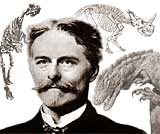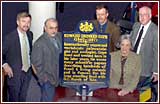LOCAL PIONEER DINOSAUR HUNTER HONORED
Memorial Dedicated to Edward Drinker Cope of Philadelphia and Haddonfield
By Hoag Levins ...| ...Nov. 7, 2002

Also see photo feature: Cope Marker Dedication Ceremony
PHILADELPHIA -- Flanked by a phalanx of towering dinosaur skeletons, scientists, historians and museum administrators gathered in the Academy of Natural Sciences' Dinosaur Hall yesterday to dedicate a memorial to Edward Drinker Cope.
Cope, who died 105 years ago, was a leader in the field of nineteenth-century natural sciences and a pioneer of the very concept of dinosaur hunting. His fossil studies through the marl fields of southern New Jersey and across the western United States are a touchstone of the modern science of dinosaur paleontology.
Philadelphia home
Yesterday's ceremony, sponsored by the Academy, the U.S. Bureau of Land Management and the State Museum of Pennsylvania in Harrisburg, featured the unveiling of a large historic marker that will be mounted outside the 21st and Pine Street site where Cope lived the last two decades of his life. The property, consisting of two adjoining row homes, was designated a National Historic Landmark in 1975.
His memorialization is of particular interest to Camden County readers because Cope spent the golden years of his scientific career as a resident of Haddonfield, just across the Delaware River from Philadelphia. In fact, the infamous "Bones Wars" between Cope and his arch rival, Othniel C. Marsh of Yale, began in Haddonfield in 1868 when Marsh visited Cope at his Kings Highway home. Their first skirmishes were over fossils in south Jersey's marl pits.
Haddonfield home
The Victorian mansion in Haddonfield from which Cope ran his half of the Bone Wars was acquired by that borough in 1924. Town officials tore

|
| Cope Photo: ANS, Philadelphia |
|
Edward Drinker Cope in the 1890s when he was a resident of Pine Street in Philadelphia. Cope was a pioneering dinosaur paleontologist and museum curator.
| the building down in 1928 to make way for a new borough hall. The Haddonfield Cope site has never been marked. A documentary book about Cope's Bone Wars House was published by the Haddonfield Historical Society in 1992.
"The 'Bone Wars' were the heyday for the science of paleontology and for the Academy," Academy president Dr. James Baker told yesterday's audience. He pointed out that although Cope roamed the country and the world during his professional life, he remained directly connected to the Academy for 39 years -- from the time he was 18 years old until his death.
For many years Cope served as the institution's curator of herpetology; specimens of the amphibians and reptiles he collected -- both existing and extinct -- are scattered throughout the Academy's vast collections.
Child prodigy
Assistant Academy curator Dr. Ted Daeschler, who hosted the commemorative program, noted that Cope's first visit to the institution occured in 1848 when he was eight-years old and that the notes and drawings the child prodigy made at that time still exist. "It's amazing to realize that some of the same specimens Cope observed and took such inspiration from are still stimulating young minds today," Daeschler said.
Just a few yards from Daeschler's podium was a glass case in which samples of Cope's notebooks, specimen bottles, fossils and scientific awards are on permanent display near the center of the great Dinosaur Hall itself -- the Academy's single most visited space.
In an address entitled "Contributions to Vertebrate Paleontology," Dr. Spencer G. Lucas, curator of the New

|
| Photo: Hoag Levins |
|
Unveiling the memorial marker are (left to right) Dr. Ted Daeschler, assistant
curator of the Academy, F. Michael O'Neill, senior paleontologist of the U.S. Bureau of Land Management, Dr. Spencer G. Lucas, curator, New Mexico Museum of Natural History, Janet S. Klein, chairman, Pennsylvania Historical and Museum commission, and Dr. Robert Sullivan, senior curator of the State Museum of Pennsylvania. Click to see larger photo.
|
| Mexico Museum of Natural History, told the crowd Cope "stands out as one of the most important paleontologists to have lived. His impact on vertebrate paleontology is indelible and it marks the science in three fundamental ways," Lucas said. "First, discovery. Cope opened up vertebrate fossil collecting fields across the country from New Jersey to New Mexico.
Important collections
"Second, collections. Vertebrate fossils collected by Cope or by his army of paid collectors form the core of some of the most important vertebrate fossil collections we have. Especially those in Washington, D.C., New York and here in Philadelphia."
"Third, and finally, research. Cope's published paleontological observations and analyses form one of the most remarkable bodies of research in the field of vertebrate paleontology. He laid the broad basis for further scientific understanding."
Michael O'Neill, senior paleontologist at the U.S. Bureau of Land Management in Washington, said that beyond Cope's scientific work, "We tend to overlook how he significantly influenced how the science of paleontology is viewed by the public today and how we as a society now care for our fossil legacy." O'Neill is one of five paleontologists on the staff of the agency that oversees federal lands in 11 western states that include some of continent's richest fossil deposits, many of which were first investigated by Cope.
Connecting past and future
The Bureau of Land Management provided the funding for the historical marker, O'Neill said, "in the hope it will remind the public of the connection between past and future, eastern cities and the Wild West, and how ideas nurtured in young minds can grow to materialize into things yet unseen."
The finale of the ceremony came as Janet S. Klein, chairman of the Pennsylvania Historical and Museum Commission, and Dr. Robert Sullivan, senior curator of the State Museum of Pennsylvania, unveiled the large marker.
Sullivan read from a statement by Anita Blackaby, director of the Pennsylvania State Museum, that said, "Cope's legacy can be summed up as that of a master naturalist. He collected and described and interpreted nature. His keen powers of observation, unquenchable curiosity, and his penetrating analyses are part of a traditon that continues today through the work of modern-day academics and museum professionals. This marker dedication stands" as a testament to that.
|





